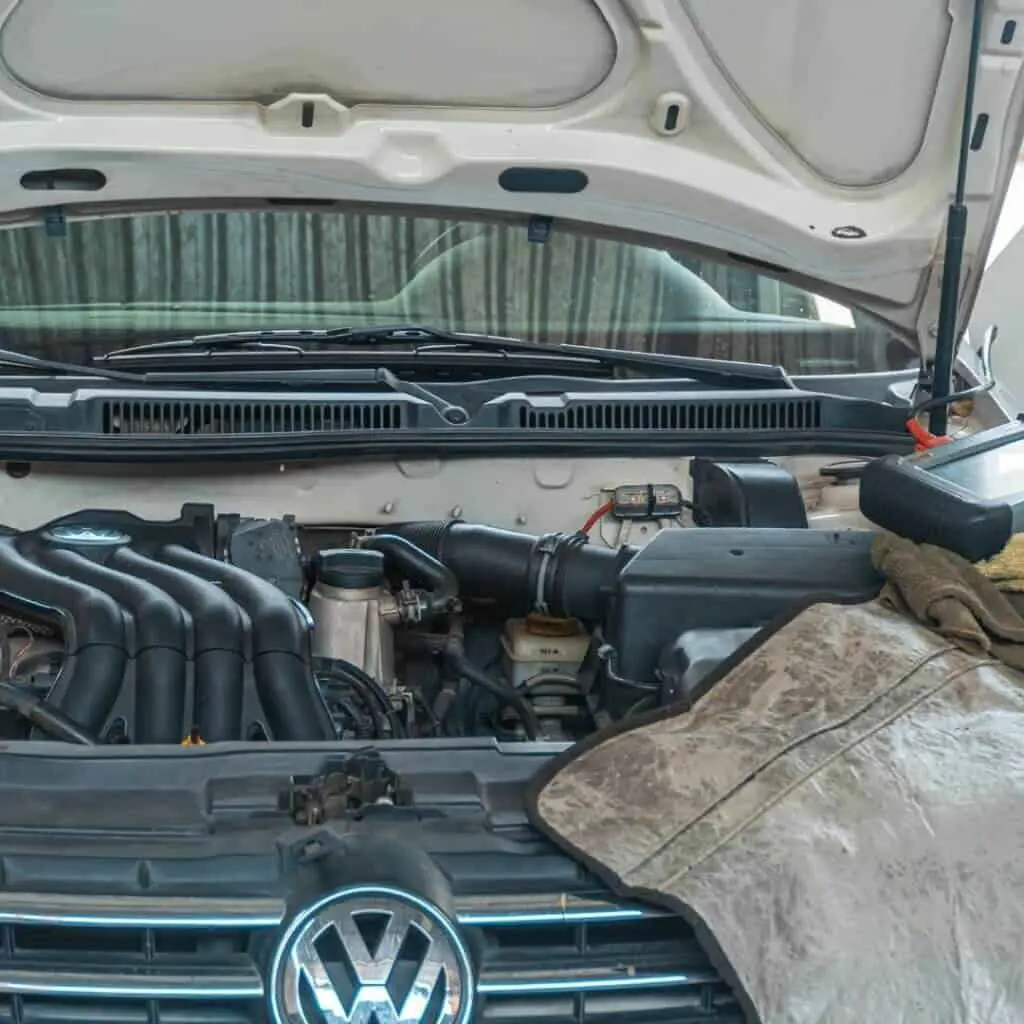Are you familiar with Chevrolet Captiva problems?
The Chevrolet Captiva is a seven-seat midsize crossover SUV produced by General Motors and sold under the Chevrolet brand. The first generation was produced by GM Korea, which was revealed in 2004 and introduced in the market in 2006.
The Captiva is powered by an Australian-built 3.2-litre Alloytec V6 engine paired with a five-speed automated transmission. It later received a four-cylinder VCDI common rail turbo-diesel engine in 2.0-liter and 2.2-liter versions. It is available with front-wheel or all-wheel drive.
The car offers a high fuel efficiency rating and sophisticated features. These include an anti-lock braking system, automatic climate control, alloy wheels, and fog lights. However, like all other vehicles, it also suffers several issues that affect its reliability and performance.
The Chevrolet Captiva’s most significant concerns are a lack of power due to engine failure, transmission problems, battery issues, broken seats, and electrical troubles. In some circumstances, these problems are caused just by faulty or worn parts.
In others, they result from poor maintenance or improper installation. These problems can severely limit the vehicle’s performance and result in costly repairs.
Common Chevrolet Captiva Problems

- Engine problems
The engine life of a Chevrolet Captiva should be at least 100,000 miles. However, some users have complained of engine failure early at around 40,000 miles, thus forcing the user to replace the engine. Engine problems are most common in 2012, 2013, and 2014 Captiva models.
Captiva’s engine issues are numerous. There have been reports of excessive oil consumption, timing chain failure, engine roughness, and a malfunctioning camshaft actuator sensor. These issues can cause the engine to stall, backfire, and produce hissing, spitting, and popping noises. [1]
One of the common issues is that the engine may start unintentionally. Repeated key insertion can result in severe wear on the ignition cylinder’s internal component’s trigger. As a result, if the ignition key is left in the lock-off position and the gear is engaged, the engine may start involuntarily.
Fuel leak defect is another reported issue. In some Chevrolet Captivas, especially model years 2007 to 2010, a fuel leak may occur due to partial or total removal of a fuel feed hose connector. This fuel leak causes engine stalling and, in the worst-case scenario, a fire in the engine bay [2].
Certain cars with a stop/start system may experience starting motor failure while driving because of thermal damage to the starter cable. This could result in accidents. The diesel particulate filter’s malfunction could also trigger the lower engine compartment covering to overheat and cause a fire.
- Transmission Failure
The transmission transfers power from the engine to the wheels, allowing you to drive at your desired speed. Because the transmission is responsible for converting the appropriate amount of power to the appropriate speed, minor transmission issues should be rectified immediately to avoid further damage.
Transmission faults are the kind of car problem that everyone notices. Chevrolet Captiva has transmission issues such as shifting delays, slipping, grinding, or leaping during acceleration.
It also experiences vibrations, whistling noises, and a burning smell emanating from beneath the hood. The most common cause of slipping is a worn-out clutch.
In Captiva, low transmission fluid level is the leading cause of all transmission problems, from slippage to unusual sounds. If the fluid level is low, various problems, including overheating, can occur, causing the transmission to slip. Low fluid may be the result of transmission fluid leaks [4].
In addition, the problem could be due to burnt fluid. Transmission fluids must be replaced regularly to remain in good condition. If it is not changed for an extended period, it burns, and the number of contaminants in the fluid might reach dangerous levels. This causes transmission malfunctions.
Other reasons for transmission failure include gear wear, broken transmission bands, and a failing torque converter. When these components are damaged, your transmission will have trouble. If you ignore these transmission problems, you could lose fuel efficiency or be unable to drive your Captiva.
- Electrical System Problems
The battery, starter, alternator, and other electrical system components are critical for proper vehicle functioning. The battery starts the vehicle and powers all the comfort features, including air conditioning, radio, and power windows.
When these components stop functioning efficiently, they produce less electricity. You will notice reduced engine power, increased emissions, and a fall in mileage. Sometimes the entire car system fails, and you cannot use your car at all [5].
A faulty alternator is another cause of a malfunctioning electrical system. An unhealthy alternator reduces the capacity to charge the battery and supply power to start your car. These electrical issues result in sluggish, dim dash lights and dome lighting or malfunctioning electrical accessories, such as starter motors and spark plugs.
Furthermore, an electrical system failure could result from short circuits or blown fuses. Extreme short circuits are hazardous because they can damage wires and other appliances and might even start a fire.
- Battery Issues
The most common and significant issue is a dead or defective battery. If you have trouble starting your Captiva or your engine has no power, the battery is typically the first thing to check.
The battery won’t have enough power to function properly in case it is drained or toward the end of its life. Thus, starting the car will take longer than usual, and the engine will be cranking slowly and clicking rapidly.
Common battery issues include loose terminal connections, damaged wires, and corroded or loose terminals.There have also been issues with the battery getting too hot. [6]
- Broken Seats
A blown fuse, wiring failure, and gear alignment difficulties are the main reasons the power seats break in your Chevrolet Captiva car. There are wires beneath the seats. Adjusting the seat can cause the wiring to be strained, kinked, or ripped, causing the seat to break. [7].
All power seats are powered by electricity, and all vehicle power systems have fuses to protect them. Thus if the fuses blow out, they will cause the power seat to malfunction. External obstructions, such as a piece of trash or a child’s toy, have hindered the power seat functionality.
Another issue affecting power seat functionality is either seat controls or seat motors. Seat controls are exposed to moisture and other pollutants that can contaminate them, causing them to cease functioning. Seat motors are what move the power seat. Sometimes they are overworked and might fail with time.
Fixing Chevrolet Captiva Issues
As always, servicing and closely monitoring your car’s performance are the best ways to detect a problem and avert engine failure. Since this is a significant part of your car, it is best to have a professional diagnose and repair any problems.
Your car transmission should be inspected regularly to diagnose, correct, and prevent catastrophic transmission problems. Chevy suggests replacing the transmission and differential fluids at predetermined intervals with Chevrolet-approved transmission fluid [8].
It is always advisable to take it to Chevy’s specialized mechanics, who will service your car following the manufacturer’s instructions. All electrical issues in your car can be sufficiently worked out by a professional car electrician who can diagnose specific issues in the area where they are found.
A faulty battery should be replaced immediately, and in the case of corroded terminals, they should be cleaned thoroughly. Also, ensure correct wire connections to avoid short-circuiting within your car’s electrical system.
Read Also: VW T-Roc Problems
Conclusion
The Chevrolet Captiva is an excellent SUV that combines efficiency and design. The most straightforward approach to solve the issues mentioned above is to have it inspected and serviced regularly to replace any worn or damaged components.
It is also critical to verify that the engine is tuned correctly and that all its accessories are properly stable. Check the fluid levels, inspect the wiring, and ensure all settings are proper.
By implementing these measures, Captiva owners may help ensure their vehicle operates smoothly and reliably for decades. Your car’s overall dependability will suffer less damage if the problem is resolved quickly.
Read Next: Kia Stonic Problems




